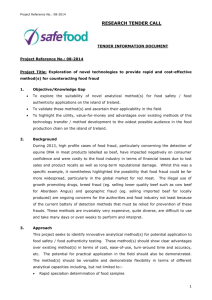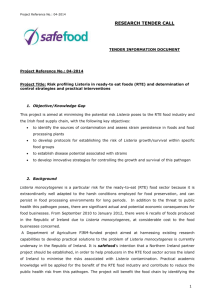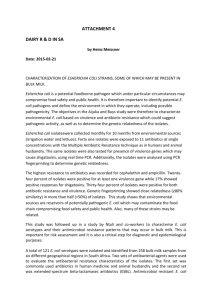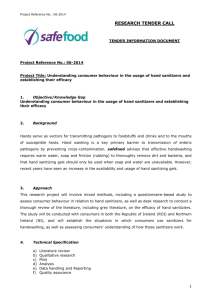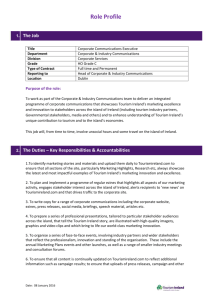Information Document for Project Ref No. 08-2013
advertisement
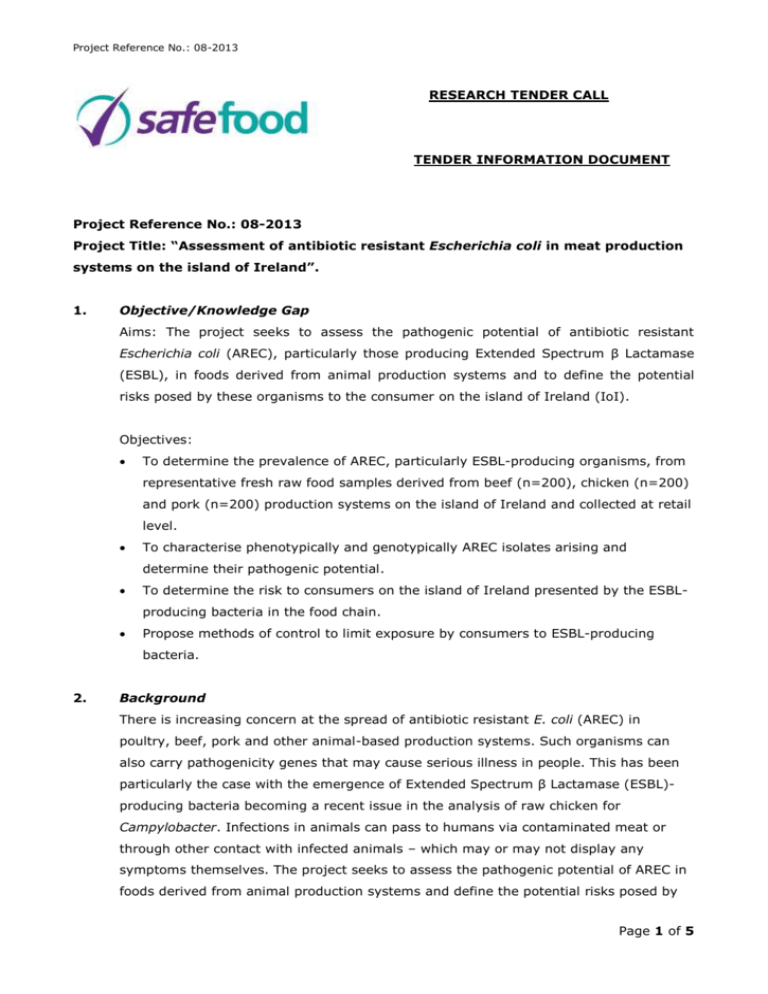
Project Reference No.: 08-2013 RESEARCH TENDER CALL TENDER INFORMATION DOCUMENT Project Reference No.: 08-2013 Project Title: “Assessment of antibiotic resistant Escherichia coli in meat production systems on the island of Ireland”. 1. Objective/Knowledge Gap Aims: The project seeks to assess the pathogenic potential of antibiotic resistant Escherichia coli (AREC), particularly those producing Extended Spectrum β Lactamase (ESBL), in foods derived from animal production systems and to define the potential risks posed by these organisms to the consumer on the island of Ireland (IoI). Objectives: To determine the prevalence of AREC, particularly ESBL-producing organisms, from representative fresh raw food samples derived from beef (n=200), chicken (n=200) and pork (n=200) production systems on the island of Ireland and collected at retail level. To characterise phenotypically and genotypically AREC isolates arising and determine their pathogenic potential. To determine the risk to consumers on the island of Ireland presented by the ESBLproducing bacteria in the food chain. Propose methods of control to limit exposure by consumers to ESBL-producing bacteria. 2. Background There is increasing concern at the spread of antibiotic resistant E. coli (AREC) in poultry, beef, pork and other animal-based production systems. Such organisms can also carry pathogenicity genes that may cause serious illness in people. This has been particularly the case with the emergence of Extended Spectrum β Lactamase (ESBL)producing bacteria becoming a recent issue in the analysis of raw chicken for Campylobacter. Infections in animals can pass to humans via contaminated meat or through other contact with infected animals – which may or may not display any symptoms themselves. The project seeks to assess the pathogenic potential of AREC in foods derived from animal production systems and define the potential risks posed by Page 1 of 5 Project Reference No.: 08-2013 these organisms to the consumer. 3. Approach The project will involve analysing representative fresh raw food samples derived from beef (n=200), chicken (n=200) and pork (n=200) production systems on the island of Ireland to test for antibiotic resistant Escherichia coli, particularly those producing ESBL. Isolates will be collected and phenotypically and genotypically characterised, using appropriate methods, to determine the basis of antibiotic resistance and to determine the pathogenic potential of these organisms. Additionally, information on the characteristics of production systems from which these isolates originated will be recorded, as possible. Data from this survey will be analysed to determine any associations between food production systems, antibiotic resistance characteristics and pathogenic potential. This will allow the risk to consumers on the island of Ireland presented by the emerging threat of ESBL-producing and other organisms in the food chain to be determined and possible methods of control to be proposed. 4. Technical Specification (a) Literature review (b) Sample collection (c) Sample analyses (d) Data analysis (e) Data handling and reporting (f) Quality assurance (a) Literature review A full and thorough review of the literature around AREC in the food chain, particularly ESBL-producing E. coli, should be done. It should include peer reviewed publications and also a full search of the grey literature including government and other organisation reports, and conference proceedings etc. Page 2 of 5 Project Reference No.: 08-2013 (b) Sample collection Samples of fresh raw beef (n=200), chicken (n=200) and pork (n=200) will be collected at retail level from major population centres according to a representative sampling plan that should be specified and that provides for 50% of the samples being collected in Northern Ireland and 50% in the Republic of Ireland. All point of sale and packaging information (where appropriate) should be recorded together with details of the date and location of purchase. Samples should be individually collected and packaged in a fashion that prevents contamination and transported to the laboratory in a temperature controlled environment, where upon analyses should commence within 24hours of collection. The sampling methodology and sampling plan must be approved by safefood in advance of the survey. (c) Sample analysis Food samples should be analysed using appropriate approaches that enable the isolation of AREC, particularly focusing on ESBL-producing E. coli. Phenotypic and Genotypic analysis of resulting isolates should be performed using specified methods and the pathogenic potential of these isolates determined using appropriate specified methodologies. A detailed experimental plan describing the methodologies that will be followed must be approved by safefood in advance of the survey. (d) Data analyses All data gathered must be analysed using appropriate statistical methods to enable the identification of any associations between food production systems, the presence of antibiotic resistance organisms and their pathogenic potential. The analyses performed should elucidate the risk to consumers on the island of Ireland presented by the emerging threat of ESBL-producing and other antibiotic resistant E. coli in the food chain and possible methods of control. Page 3 of 5 Project Reference No.: 08-2013 (e) Data handling and reporting 1. The contractor will submit to safefood, on a six monthly basis, a summary report containing details of the progress for each deliverable of the project. 2. Interim reports (electronic and hardcopy) containing a summary of the findings to date will be submitted to safefood at six monthly intervals of the research. 3. The contractor is responsible for collating all results and a final report will be submitted to safefood on completion of the study. 4. All forms, documentation and electronic files must be retained by the contractor until further notice from safefood in case of issues arising after the completion of the research. (f) Quality assurance The contractor must ensure a high level of accuracy in data entry, checking and backup and analytical competence and should provide an outline of how data produced will be validated, analysed and interpreted. safefood may visit the contractors during the course of the research to assess how the work is being carried out. Applicants should provide details of participation in proficiency tests and interlaboratory comparison schemes for analyses relevant to this work. Applicants should provide documentary evidence that laboratory quality assurance and quality control measures are in place. 5. Proposed Activities/Deliverables Literature review. Provision of a sampling plan for the inspection of fresh raw beef (n=200), chicken (n=200) and pork (n=200) samples at retail level on the island of Ireland. Page 4 of 5 Project Reference No.: 08-2013 Provision of a detailed experimental plan describing the methodologies that will be followed. Submission of 6 monthly summary reports. Analysis of the final dataset, collation of the results and drafting of a final report to be submitted to safefood within the 18 month study period. 6. Evaluation of Tenders Tender bids will be evaluated according to the quality of proposals and applicants using the following criteria: Quality of the proposal: Anticipated deliverables; Research method; Value for money; Potential for application; Work plan, including the overall timeframe. Quality of Applicants: 7. Experience in subject area; Existing facilities; Quality Assurance and Quality Control measures in place. Duration of Project Estimated duration of the project: Total of 18 months. A detailed timescale of research should be submitted by each applicant. 8. Scientific Aspects Potential applicants are encouraged to contact the Research Administration Office at safefood for further information about this research project. Page 5 of 5
